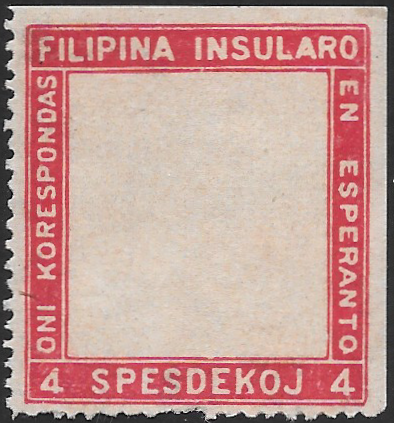Esperanto Stamp Collar
Updated and republished 24th February 2023 after the 4c stamp was added to my collection.
Stamp collars are labels that contain a blank space where a postage stamp can be affixed. The collar with the affixed stamp is then applied onto the envelope. Stamp collars are used for advertising, fund raising or for promotion of a particular cause/political view.
Collars were quite popular in Europe in the early 1900’s (known as “Porte Timbres” in French; meaning “Stamp Carriers”). In the United States stamp collars have historically been pre-printed onto envelopes, rather than being affixed by the user.


Above are pictured 2 stamp collars from the Philippines. Both are in mint condition and do not have an affixed stamp. Based on the advertisement below there are 3 different colors; green, blue and red. I’ve never seen the blue and have not been able to ascertain its value. These collars were made for sale by the Filipina Esperanto Association as a fundraiser – advertisements for these stamps first appeared in their magazine “Filipina Esperanto” in April and May of 1908.


The advertisement from May had an additional line of text stating simply that 500 copies were available. I assume this to mean 500 copies of each stamp collar in each color. This particular collar is clearly promoting the use of the Esperanto language in the Philippines at the time. The translation of wording on the stamps “Filipina Insularo en Ensperanto oni Parolas” translates to “Filipino archipelago is spoken in Esperanto”. The price marked on the green example above is 2 Spesdekoj. The 4 Spesdekoj stamp has slightly different text on it translating to “Correspondence in the Filipino archipelago is in Esperanto”.
With only 500 copies of each stamp these are obviously quite scarce.
Great! But what is Esperanto?
Esperanto is a constructed language, not native to any particular persons or region – it is regarded as an IAL (International Auxiliary Language). It was created by a Ludwik Lejzer Zamenhof, a medical doctor (ophthalmologist) in Poland in 1887. As well as being a medical doctor Zamenhof was a linguist who spoke many different languages himself. He designed Esperanto to be a language that is easy to learn by all races with the vision of unity of humankind through communication. The goal was for ordinary people to be able to easily learn Esperanto as a second language and therefore be able to communicate with people from other countries using an international language.
Esperanto is rooted largely in Latin with Russian, Polish, German and English influences. Esperanto has simple grammar rules, is based on phonetic spelling and with it’s roots in the aforementioned languages is easy for many people to learn. Esperanto is now making a comeback with many people learning it as a second language.
Esperanto also defined International Monetary Units. This is an incredible concept when you think about it – over 100 years later you can see the parallels with what Bit Coin is now doing as an international currency. The Esperanto currency, however, was not widely adopted for use.
In relation to the Philippine Peso the Esperanto monetary units correlated to:
- 1 spesos = 1/10th of 1 centavo
- 1 spesdeko = 1 centavo
- 1 spesmilos = 1 peso
Dr. Zamenhof was nominated 12 times for the Nobel Peace Prize for his vision and work on Esperanto and even has a planet named after him. With the renewed focus of people wanting to learn Esperanto as a second language his vision may still come to light.
Thanks for reading, happy hunting and have fun with your collection!
